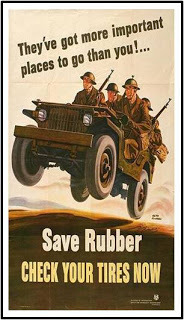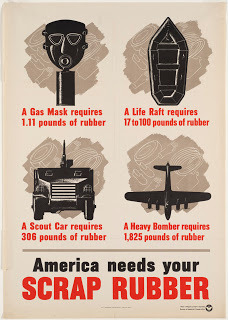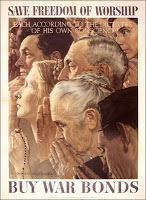Sarah Sundin's Blog, page 535
January 19, 2011
Taming Time - Practical Tips to Increase Writing Productivity
 Today I'm guest blogging over on Novel Journey on time management for writers: "Taming Time - Practical Tips to Increase Writing Productivity. Herd up goals!Corral blocks of time!Lasso the internet!Harness time snippets! Yee-haw? Okay, so I shouldn't write westerns. Anyway...here's the link to the article: http://noveljourney.blogspot.com/2011/01/taming-time-by-guest-blogger-sarah.html
Today I'm guest blogging over on Novel Journey on time management for writers: "Taming Time - Practical Tips to Increase Writing Productivity. Herd up goals!Corral blocks of time!Lasso the internet!Harness time snippets! Yee-haw? Okay, so I shouldn't write westerns. Anyway...here's the link to the article: http://noveljourney.blogspot.com/2011/01/taming-time-by-guest-blogger-sarah.html
Published on January 19, 2011 09:49
Today in World War II History
70 Years Ago—Jan. 19, 1941: British launch offensive in East Africa, invading Italian-occupied Eritrea & Ethiopia. Chiang Kai-shek's Nationalist Chinese forces disband Mao's Communist army.
Published on January 19, 2011 03:00
January 18, 2011
Today in World War II History
70 Years Ago—Jan. 18, 1941: German Luftwaffe begins bombing British-occupied Malta from Italy.
Published on January 18, 2011 03:00
January 17, 2011
Make It Do - Tire Rationing in World War II
 During World War II, rationing was a large part of life on the United States Home Front. Tires were the first items to be rationed.
During World War II, rationing was a large part of life on the United States Home Front. Tires were the first items to be rationed. Rubber Shortage
The Japanese conquered the prime rubber producing nations of Malaya and the Dutch East Indies in January and March of 1942 respectively, eliminating 91% of America's rubber supply. Since cargo ships were needed for military purposes, the ability to import rubber from South America was reduced. The synthetic rubber program had just begun and didn't produce enough to meet civilian and military needs. Before the war, the US had accumulated a stockpile of crude rubber - but only enough for one year at peace.
Uses for Rubber
In civilian life, three-quarters of rubber was used for automobile tires, but rubber was also used for gloves, raincoats, boots, waterproof sheets and baby pants, girdles, hot water bottles, bathing caps, garden hoses, and toys. The military required rubber for vehicle and aircraft tires, pontoon bridges, gas and oxygen masks, medical equipment, boots, raincoats, shoes, and even erasers.
Tire Rationing
To ensure enough rubber for military and vital civilian purposes, tire rationing was instituted on December 27, 1941. The program ran through December 31, 1945. Local Tire Rationing Boards issued certificates for tires or recapping upon application. Certificates for new tires were restricted to vehicles for public health and safety (medical, fire, police, garbage, and mail services), essential trucking (food, ice, fuel), and public transportation. Recapping was allowed at the discretion of the local board for any of the above, and occasionally for taxis and defense workers who shared rides. Civilians were allowed to keep five tires per automobile, and were required to surrender any others.
Rubber Drive

From June 15-30, 1942 the United States held a nationwide rubber drive. People were encouraged to donate used or surplus rubber items. The program brought in 450,000 tons of rubber, but even that didn't alleviate the shortage. Public service campaigns educated people on how to care for rubber products to make them last for the duration - protection from heat and moisture, proper cleaning, avoiding folding or crumpling, careful stretching of elastic, and speedy repair of holes or tears.
Care of Tires
Since civilians had to make five tires last the entire war, they had to be extremely careful. People were encouraged to drive less - in fact, the primary purpose of gasoline rationing was to protect tires. A "Victory Speed" of 35 mph was instituted - tires wore out half as quickly at 35 mph than at 60 mph. Slow and steady stops, starts, and turns also reduced wear on the treads. Everyone was encouraged to use public transportation, to share rides, and to avoid rough roads. Proper auto maintenance was more important than ever - brake adjustment, wheel alignment, tire inflation, tire rotation, and early repair of holes all prolonged wear. In addition, all auto racing was banned.
How would you have handled tire rationing?
Published on January 17, 2011 05:00
January 16, 2011
Today in World War II History
70 Years Ago—Jan. 16, 1941: US Army activates Air Districts for national defense (Northeast, Southeast, Northwest, and Southwest).
Published on January 16, 2011 03:00
January 15, 2011
Today in World War II History
70 Years Ago—Jan. 15, 1941: US Labor leader Philip Randolph calls for march on Washington to protest discrimination and segregation in armed forces and defense industry.
Published on January 15, 2011 03:00
January 14, 2011
The Key to Forgiving Others
 If forgiveness were easy, Jesus wouldn't have had to talk about it so much. When someone wrongs us, it hurts, especially if that someone is someone we trusted. A friend. A family member. And that hurt seeps into our souls. Our thoughts focus on the wrong done to us, and how very wrong it was. We justify our own actions and condemn the actions of the person who hurt us. Well meaning friends tell us we're right, the other person wrong. Self-righteousness and bitterness take hold.
If forgiveness were easy, Jesus wouldn't have had to talk about it so much. When someone wrongs us, it hurts, especially if that someone is someone we trusted. A friend. A family member. And that hurt seeps into our souls. Our thoughts focus on the wrong done to us, and how very wrong it was. We justify our own actions and condemn the actions of the person who hurt us. Well meaning friends tell us we're right, the other person wrong. Self-righteousness and bitterness take hold.Lack of forgiveness not only is poisonous to our souls, but ruinous to relationships. How many of you have seen workplaces, classrooms, or families contaminated by one person's actions and the other person's unwillingness to forgive?
Jesus has the answer—as always. Instead of focusing on the other person's sin and our righteousness, we need to focus on our sin and God's righteousness. When we look through God's eyes, we gain proper perspective. No one is righteous. No one "deserves" forgiveness. Yet God forgave us our millions of sins. This allows us to look at those who hurt us with new eyes, to see them as fellow sinners in desperate need of forgiveness.
As the master says to the unforgiving servant, "'Shouldn't you have had mercy on your fellow servant just as I had on you?'" (Matthew 18:33).
Servant to servant, sinner to sinner, let's offer mercy and forgiveness remembering the greater mercy and forgiveness shown to us.
Published on January 14, 2011 05:00
January 13, 2011
Today in World War II History
70 Years Ago—Jan. 13, 1941: Author James Joyce dies at age 58 in Zürich, Switzerland.
Published on January 13, 2011 03:00
January 12, 2011
Book Club Beat - Benefits of a Book Club
 Book clubs are a passion of mine. I've belonged to a book club for seven years, and I love the chance to discover and discuss fantastic books - and to forge deep, lasting friendships.
Book clubs are a passion of mine. I've belonged to a book club for seven years, and I love the chance to discover and discuss fantastic books - and to forge deep, lasting friendships.This month I was interviewed by Nora St. Laurent of The Book Club Network for Christian Fiction Online Magazine about my experiences in a book club - the benefits as a reader and now as a published author. You can read the interview here: http://www.christianfictiononlinemagazine.com/biz_bookclub.html. While you're there, check out the rest of this outstanding magazine.
If you're interested in finding or starting a book club, I highly recommend The Book Club Network (http://www.bookfun.org/), an online community for book club members, leaders, and for authors too.
Do you belong to a book club? How have you benefitted from it?
Published on January 12, 2011 05:00
January 10, 2011
Lessons from the 1940s - Freedom of Worship
 During World War II, President Roosevelt declared Four Freedoms he felt were fundamental to humanity: freedom of speech and worship, and freedom from fear and want.
During World War II, President Roosevelt declared Four Freedoms he felt were fundamental to humanity: freedom of speech and worship, and freedom from fear and want.The freedom of worship is encoded in the Bill of Rights of the US Constitution: "Congress shall make no law respecting an establishment of religion, or prohibiting the free exercise thereof." This twofold freedom has defined religious life in America for over two hundred years. No one can coerce us into any religion, and no one prevent us from following our faith.
If only this were easy to practice. The secular portion of American culture stresses the first part of the amendment - while people of faith prefer the second portion. In reality neither can exist without the other.
Many of the founders of the United States fled Europe because of state-mandated religion. For centuries Europe had been rocked by war and persecution as Catholics and Protestants battled for control of governments. The writers of the Constitution wanted none of that. They wanted a new type of country where your life did not depend on the religion of the current regime. Many people of faith, if we're honest with ourselves, think this country would be better off if everyone believed as we did. However, do we really want people to believe because they have to - or because they want to? God never forces people to come to Him...He draws with cords of love.
On the flip side, secular people must remember that people of faith have the Constitutional right to practice that faith - and that includes the right of speech. The current cry for tolerance carries a hidden message - to tolerate someone else's beliefs means to silence your own. However, the Constitution does not include a right to not be offended. In fact, the right of free speech means all of us will be offended and often. Would you have it any other way? To silence those you disagree with carries the risk that you'll be silenced yourself. To prevent someone from worshipping as they choose coerces them into the religion of no religion.
I believe freedom of religious speech should be practiced with love, respect, and intelligent debate - not with angry, strident, insulting yelling-over-the-other-person. But that's my opinion, and you're free to disagree.
What are your thoughts on freedom of worship?
Published on January 10, 2011 05:00



